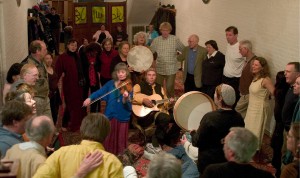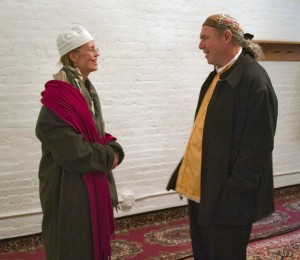When lights went out ………….all over Europe
Visit to Auschwitz and Birkenau, Palm Sunday 20 March 2005
In early March this year I offered to go with my friend Jo to Poland, specifically to visit the concentration camps near Krakow. Jo, a non-Sufi non-DUP yet like-minded friend of many years, had recently been inspired to create some artwork on the occasion of the 60th anniversary of the liberation of Auschwitz/Birkenau and now wanted to visit there in person.
We flew to Krakow on a Saturday, and that evening Jo and I prepared for our visit with the healing ritual, adapted for places of great suffering as recommended by Saul. During our bus journey the next day, and throughout our time at the camps, the Sufi Invocation was constantly on my breath, and I felt an increasing gratitude for this constant sense of support as, entering beneath “Arbeit maketh frei”, we were surrounded and immersed and had no choice but to look, see, imagine. I was aware of my face becoming more and more drawn, I avoided looking at others, and noticed that most people were responding similarly.
That evening, back at our hotel in Krakow, having showered and changed our clothes, Jo and I found our own ways of beginning to process some of what we’d experienced. She wrote and wrote whereas I sang and danced, sang and danced. First, all the Dances of Universal Peace honoring the Jewish tradition, again and again. Then the first line of the Aramaic Prayer, closing with saying the whole prayer. Finally the spoken Fateha, switching my focus of concentration to peace in the Middle East.
Some days later, back home again in Edinburgh, I opened my computer and began to write about my experiences – and this is what I’d now like to share with you …………
Aware of my feet as I walked along Edinburgh’s streets, it seemed incredible that these same shoes had, only a few days previously, walked along stony paths, along concrete corridors, through mud and across rubber matting, up stairs, along railway sleepers, across grass. They had taken me to Poland. They had taken me to Auschwitz and Birkenau (known also as Auschwitz II). They had followed our Polish guide as she expertly swept us along in the allotted time from room to room, building to building, all the while delivering a clear and factual account of what was before us. And today, before walking out in them again in my home town of Edinburgh, I had stopped to recall where these shoes had last walked before brushing the dust of Auschwitz from them.
Shoes, shoes, shoes. A mountain of shoes behind glass, footwear of all kinds, heavy shoes and light shoes, expensive, cheap, tatty, new, adult’s, children’s, sandals, clogs. Colored shoes were there for sure, yet somehow the memory is of grayness, dust-covered, worn-down. Where had these shoes been worn for the last time? Did they walk to the gas chambers, the solitary cells, the execution yard? Were they scrabbling for footing at the sides of ditches being dug for the corpses? With respect, human security, even self-respect and hope of every kind completely gone, did they in fact carry their owners willingly to their demise? Was that final walk, for some, made in dignity and knowingness, a voluntary giving up of life when the life left to them was no life at all?
Shoes were not the only items on display behind glass walls. Women’s hair filled another huge display area; pots and pans and various kitchen items; walking sticks, crutches and artificial limbs; hair and shaving brushes; dentures; spectacles; clothing, even from babies. Everything that could be salvaged from the human body was salvaged. Taken from the despised, nevertheless it was all destined for recycling to help support German soldiers wounded in battle – also providing a double bind for the SS themselves, double binds being needed to keep them in thrall to an insane regime. A terrible symbiosis underpinned by fear on both sides.
Our introduction to Auschwitz had been by means of a video in a room full of people, many standing. Some scenes were familiar, but what was new was that many of these photos were not stills – sudden movements of the emaciated and hollow-eyed somehow seemed shocking, a timely reminder that, in spite of their appearance, these people had indeed been alive when the photos were taken; a reminder of the endurance of the human spirit, with body wasted and frail beyond imagination; a reminder of the strength of the will to live, perhaps seen here in its last resort.
In Auschwitz we saw cells for solitary confinement, the suffocation cell, an enclosed yard where executions by firing took place. We saw improved quarters for camp informers and the superior rooms used by the SS. We also stood inside the old gas chambers beneath the holes from which cyanide had been dropped. Bodies had been crammed into the space to provide sufficient natural heat to vaporize the cyanide pellets. We saw the ovens. But extermination at Auschwitz was not efficient enough. With 700 bodies per day to dispose of and the crematoria only able to cope with half that number, the gas chambers and ovens were closed down in preference to the more extensive and efficient procedures being built at Birkenau, a huge concentration camp intended to take in men, women and children. Whereas the buildings at Auschwitz were brick-built, having previously been an army barracks, those at Birkenau were wooden pre-fab constructions, supplied from Germany. Originally intended as stables for 50-plus horses, at Birkenau each hut provided sleeping space for 700, sometimes increasing to 1,000. Night-time space would be a better description than ‘sleeping’, the wooden-slatted bunks being in tiers of 3, each wide enough for 10 bodies, provided all turned at the same moment. Space between the bunks was minimal, so the scene as one looked down the length of the room was of almost continuous wooden slating interspersed by upright supports. It was the fittest who were able to climb into the preferred top bunks, knowing at least they would not be covered by dripping excrement from bodies exhausted with diarrhea lying in the bunk above. A few burning coals in a bucket were provided when the temperature dropped sufficiently below freezing, and this in Silesia, a coal-mining area of Poland. Ironically these rooms provided jobs in which people were most likely to survive – cleaning the latrines, the battery of holes barely giving shoulder-to-shoulder space and which in-mates were allowed to use twice a day. Cleaning these was preferable in terms of life-expectation, in spite of the stench and risk of infection, to having to walk in all weathers to hard manual work in the labor camps. Running water was laid on after Birkenau had been functioning two years – prior to that prisoners had no alternative but to drink supposedly purified recycled water from latrines and primitive washing facilities.
Birkenau is enclosed by deep ditches inside double perimeter fences of wire and barbed wire, interspersed by watch towers. I stood between these double fences, attempting to imagine escaping through one in darkness only to be caught by searchlight before the second. The tallest tower above the entrance gate, with rail tracks passing beneath, provides a view of the whole camp. I stood here also, this time attempting to imagine myself in SS shoes, hearing the rumble and clanking of the next trainload to arrive. Gazing across the huge area of the camp I imagined it filled again with the wooden huts that once occupied this space. Complete huts only occupy the foreground now, the SS having burned down the majority in the last days of January 1945, before liberation. Only the brick chimneys survived, two to each hut, neat rows of twin chimneys now covering the ground to the far perimeter fence. Beyond the fences the land between Auschwitz and Birkenau had been kept free of buildings and trees, so that escaping prisoners could be better seen, and this was also where ash from the crematoria was spread, as fertilizer.
Eric Berne taught that, under stress, we regress to either a childish part of ourselves or a part that we involuntarily absorbed from our parents, depending on who we are currently communicating with and the context. Thus, under the conditions of a concentration camp, in-mates would be likely to react from their Conditioned Child ego-state towards the very real (rather than subjectively perceived) Authoritarian Parent ego-state of their aggressors. The Games People Play (Eric Berne, 1964) would be played out at the ‘nth’ degree, with destructive or self-destructive endings. Further, if the SS were to function effectively, they needed to be kept in bondage to their insane regime – and that was carried out not only from the threat of death they themselves faced if they failed in their duties, but from believing they were morally right to do what they had to do. In a wider context, perhaps one needs to remember that the so-called science of eugenics had been interesting Western intellectuals for some time. Any humane feelings that might begin to surface in an individual Nazi were therefore a threat to their own life and had to be squashed; any feelings of compassion and the whole house of cards could start to come down. Unlike the ‘Games’ that people usually ‘play’ (ibid), the whole set-up was self-perpetuating with no likelihood of an end being brought about by the ‘role’ change normal in human social interactions. Only intervention from outside could do that – and contemplation of that raised questions in my mind of the outside world, of not only Poles, not only Germans but the whole of the Western world. Where was the country that really opened its doors to Jews and Gypsies?
The words of a children’s song ask: “When I needed a neighbor were you there, were you there? When I needed a neighbor, were you there?”
Knowing, feeling, accepting that the darkness of the concentration camps, of victims and perpetrators both, is shadow residing within myself, since Palm Sunday this year I’ve found myself changing the words to: When you needed a neighbor, where, oh where, was I?
Lights indeed went out all over Europe.
Alice Fateah Saunders
March 2005



















